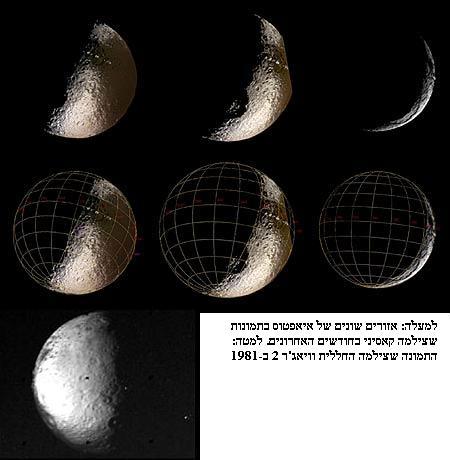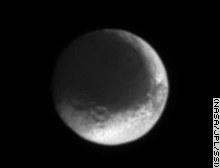Photographs of Iapetus from Cassini cameras reveal a world full of contrasts

The Cassini spacecraft is scheduled to make a flyby of Saturn's moon Aetaphus, a world made up of two completely different halves. One side of Aiatpus is light as snow while the other is covered with a dark pitchy substance.
At 01:30 GMT on January 1st (03:30 our time) Cassini will pass at a distance of 123,400 km from the cold moon. Some scientists believe that the dark matter on the surface of Iatpus came from space while others believe that it erupted from inside the moon.
The transit flight may bring scientists another step closer to understanding the process that is responsible for the strange phenomenon.
"Iapetus is one of the most interesting satellites we're going to visit with Cassini," said Dr. Carolyn Porco, who heads the mission's imaging team. "It is almost certain that this is an important planetary process that begs us to investigate it in depth." saying.
Cassini will come a little closer to Iapetus than Voyager 2 did in 1981. The current approach will occur over the dark side of the moon, which has never been seen at close range.
The best image of Iapetus taken by Voyager had a resolution of 8 kilometers per pixel, while those taken by Cassini during this transit will be about XNUMX kilometer per pixel.
The dark part is rich in organic (carbon-based) molecules that covers that side of Iapetus leading in the direction of the Moon's orbital motion around Saturn, except for the polar regions. It is possible that the dark earth was thrown into space by the collision of another moon of Saturn. Over time, the drifting dust moves toward Saturn. Eventually Iapetus flew through the cloud and grabbed some of these materials. The cloud itself has already been swallowed up inside Saturn. This is why only one side of Iaptos is painted with the organic material.
The second possibility is that the material originates from Iaptus itself. It is possible that it was thrown to the surface due to a violent event or in some other way that we don't know, says Dr. Furko. "Volcanic activity can cause different things. It could be the cause of material coming out of permanent fissures of the kind we see in Iceland, but if volcanism is involved, it would be glacial volcanism."
"Scientists also want to know how the dark matter got its shape and boundaries. It looks like a baseball with part of the skin torn off it," said Proko.
In recent Cassini images, you can see a line of mountains appearing as a band of bright spots around the moon's equator. The mountains were first discovered in a Voyager image, and may rival the tallest mountains on Earth, the fair moon Io, and possibly even those of Mars. Cassini also discovered a circular formation in the southern hemisphere, which may be an impact crater. The diameter of the crater seems to be over 400 kilometers.
Iapetus, which is 1,436 kilometers in diameter, is Saturn's third largest moon. In Greek mythology, Iapetus was a Titan - one of the race of god-like giants born to Uranus and Gaia.
On December 25, Cassini released the European Space Agency's Huygens spacecraft and it is now making its way to the large moon Titan.
Cassini: First images of the two-faced moon Iapetus
17.7.2004 by: Avi Blizovsky

Iaptus - a light hemisphere and a dark half
The Cassini spacecraft has taken the first images of the two-faced moon, Iapetus, and they may hold clues as to why this moon has a dark hemisphere while the other half is bright.
Researchers at NASA's Jet Propulsion Laboratory hope that Cassini's observations will lift some of the mystery of the moon and help determine where the dark matter came from.
The spacecraft took pictures of Iapetus (pronounced (eye-APP-eh-tuss) from about 2.9 million kilometers away on July 3, a few days after Cassini entered orbit around Thebes.
Iapetus is among Saturn's 31 known moons and is about one-third the diameter of our Moon. It was discovered in 1672 by the French-Italian astronomer Jean-Dominique Cassini.
According to one theory, the dark side is covered by particles ejected from the tiny moon Phoebe. Another theory is that the materials rose up from the moon, an idea supported by observations of materials at the bottom of craters.
